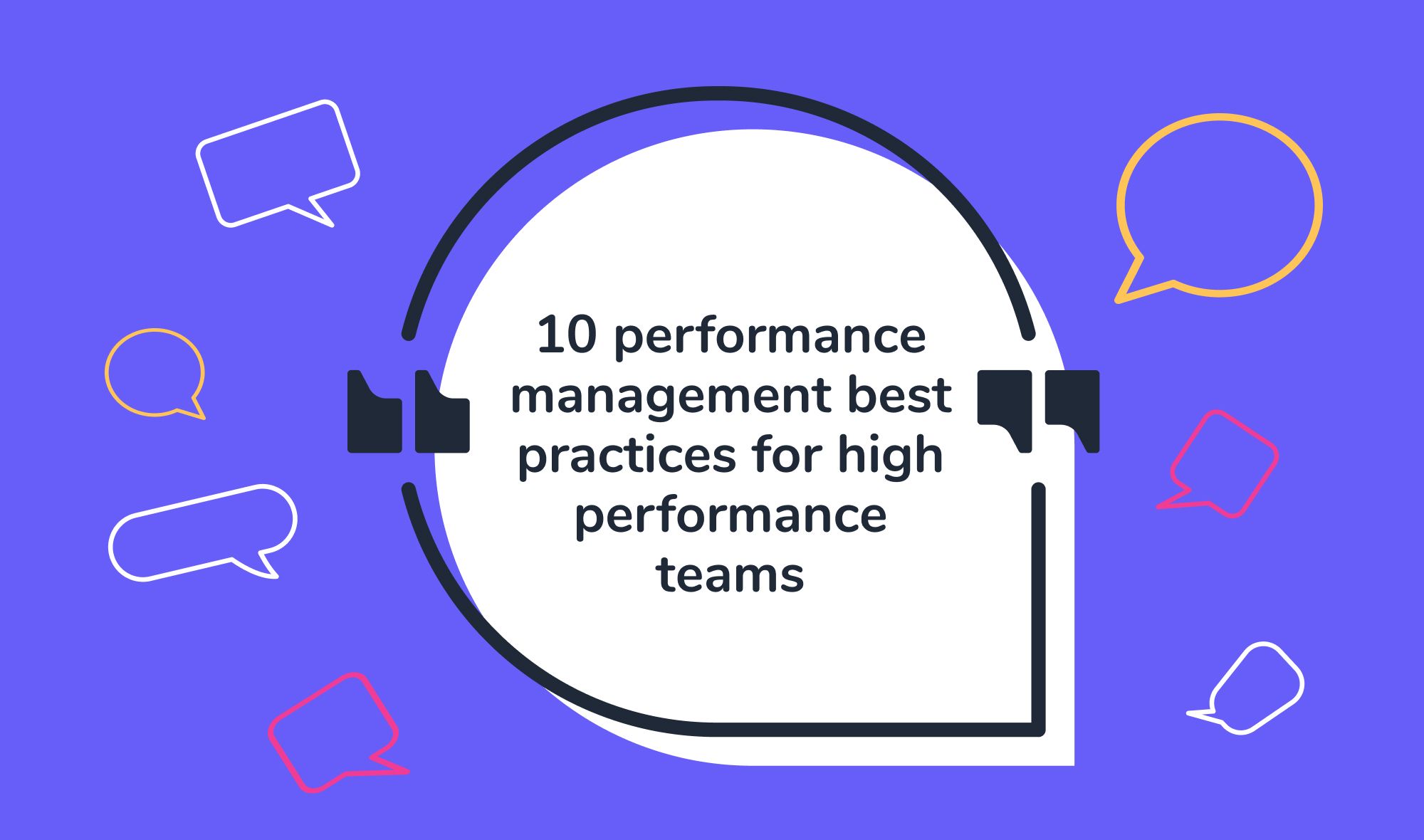Leading with impact: a high performance management approach
By Julian Lewis • February 7, 2023

In today's business environment, peak employee performance and effective management skills are more important than ever. Companies are facing increased competition and a rapidly changing market, making it crucial to have a strong and effective leadership team in place. High-performance management helps organizations to stay agile and adapt to change, while also driving growth and innovation. If you want to learn more about how diversity and inclusion initiatives can enhance high-performance teams, check out this insightful post.
If you are ready to start leading with impact using a high-performance management approach, you've come to the right place. In this post, we will explore the key principles of high-performance management and provide practical tips and strategies for implementing this approach in your organization.
Whether you're a CEO, a seasoned executive, a middle manager, or team leader, this guide will help you to create a culture of excellence and drive outstanding results for your business.
Join our Newsletter
Transform your career with our personal growth insights. Get one valuable tip right in your inbox every Saturday morning.
What is a high-performance management system?

High-performance management is a leadership approach that focuses on creating a culture of excellence and achieving exceptional results with highly engaged employees. The approach is designed to drive growth, innovation, and adaptability within teams, and it is used to stay competitive in today's fast-paced business environment.
This approach also encourages employees to take ownership of their work and strive for excellence, helping to create a positive and productive work culture, and ultimately driving the organization's success.
5 Essential elements of a high-performance management strategy

A high-performance management system may not work the same way for every organization, as every team is unique and has different business goals, challenges, and resources. However, the principles of a high-performance management system can be adapted to suit the specific needs of any company.
The key elements of a high-performance management approach include:
1. Setting clear goals:
A high-performance management approach starts with setting clear and measurable goals for the organization and its individuals. The leader plays a critical role in goal setting and ensuring they align with the organization's overall mission and vision.
They also need to communicate these goals effectively to the team and provide the necessary resources and support to achieve them. This will require transparent communication and ongoing discussions with each team member.
2. Providing support and resources:
A leader focused on performance management should provide their team with the necessary support and resources to achieve their goals. This includes providing training and development opportunities, access to the right tools and technology, and a positive and inclusive work environment.
3. Holding individuals and teams accountable:
A leader should hold high-performance individuals and teams accountable for their performance and progress toward achieving goals. This includes providing regular employee feedback, setting expectations and consequences for meeting or not meeting goals, and recognizing and rewarding outstanding performance.
Join our Newsletter
Transform your career with our personal growth insights. Get one valuable tip right in your inbox every Saturday morning.
4. Fostering a culture of excellence:
A leader plays a crucial role in fostering a culture of excellence in their high-performing team, by promoting a positive work environment, encouraging open communication, and fostering collaboration and teamwork.
5. Continual improvement:
The high-performance management process should be a continuous one, and leaders should regularly evaluate the performance of their team, and organization as a whole, and make adjustments as necessary. The leader should always be looking for opportunities to improve and innovate and encourage their team to do the same.
While the principles of high-performance management can be adapted to suit the needs of any organization, it's important to understand that every organization is unique, and a one-size-fits-all approach may not be effective. Therefore, a tailored approach is necessary for the best results.
Case Study: A High-Performance Management Success Story

One real-world example of a company that has implemented a high-performance approach is the software company, Salesforce. Founded in 1999 by Marc Benioff, this cloud-based software company originally focused on providing customer relationship management (CRM) software but later expanded its offerings to include a wide range of enterprise software solutions. In the early days, Salesforce was facing a lot of challenges, including a highly competitive market and a lack of brand recognition.
To overcome these challenges, the company shifted to high-performance management that focused on goal setting, peer reviews, and management oversight of individual and team performance, which helped them to achieve significant growth and success. This included consistently achieving revenue growth of over 20% year-over-year, developing a strong and dedicated employee base with low turnover rates, and being named one of Fortune's 100 Best Companies to Work For.
The company's success demonstrates that high-performance management can be a powerful tool for driving growth and success and that a comprehensive approach that touches all aspects of the organization is imperative to boost employee productivity.
10 performance management best practices for high-performance teams

Managers may struggle to set up high-performing teams for a variety of reasons. Some common challenges include difficulty in finding and hiring the right people with the necessary skills and experience, insufficient training and development opportunities for existing team members, and inadequate resources and support from the organization.
If you manage people and are struggling to build high-performance teams that consistently meet organizational goals, here is a list of 11 best practices to boost business performance and maximize productivity.
To gain a deeper understanding of the vital role of middle managers in organizations, read our blog post on Demystifying the Middle Manager: Understanding Their Vital Role in Organizations.
Assess where your company is today
First, it is important to understand the current status of your company, its goals, and its objectives. This information is crucial for developing an effective high-performance strategy that aligns with the company's overall objectives and addresses specific performance issues.
Managers who skip this step risk implementing a strategy that is not well-suited to the company's current needs. This can lead to a lack of buy-in from employees, wasted resources, and ultimately, poor performance.
For example, if a company is focused on cost-cutting, implementing a high-performance strategy that emphasizes employee development and career advancement may not be well-suited to the company's current needs and may not be embraced by employees.
A SWOT analysis, a strategic planning tool first developed in the 1960s, is a practical way to accomplish this assessment and helps identify the key factors that are likely to impact an organization's ability to achieve its goals. It also assists in developing strategies to leverage a company's strengths, mitigate its weaknesses, capitalize on opportunities, and defend against threats.

Separate employee development goals from company goals
It is important to separate employee development goals from company goals because it allows employees to focus on their individual growth and development while also contributing to the overall success of the company. When employee development is not separated from company goals, team members may feel that their personal and professional growth is being sacrificed for the company's success. This can lead to demotivation, lack of engagement, and high turnover rates.
The best way to separate employee development goals from company goals is to set individual development goals for employees that align with the company's overall objectives but also allow for personal growth.
For example, a company goal may be to increase sales by 20% in the next quarter, while an employee development goal could be to improve their sales techniques and close more deals. These two goals are aligned, but the employee development goal allows the employee to focus on their personal growth and development.
Build trust and team cohesion

When trust and team cohesion are strong, employees are more likely to be engaged, motivated, and committed to achieving the company's goals. They are also more likely to be productive, be innovative, and provide high-quality work.
If trust and team cohesion are not built, it can lead to poor communication, lack of accountability, and low employee engagement. This can result in poor performance, high turnover rates, and a lack of innovation.
Managers should make an effort to build relationships with their team members; this can be done by having regular one-on-one meetings, team-building activities or events, and social gatherings. Additionally, they should recognize and reward team members for their contributions to the team and the company to build a sense of camaraderie and collaboration. By implementing these simple strategies, managers can prioritize trust and develop a collaborative environment that will lead to a high-performing team.
Get your team invested in your company's success
Communicating the company's vision and goals to high performers and involving them in the decision-making process helps to align their efforts with the company's overall objectives and to build a sense of ownership and commitment to the company's success.
Involving top performers in the decision-making process allows them to have a voice in shaping the company's direction and to take ownership of the decisions that impact their work. This can assist with improving employee retention, as well as give new hires a positive influence and resource during and after their onboarding.
To encourage a high-performing team to invest in the company's success, managers should provide them with challenging projects or "stretch" assignments that push their abilities to the limit and get them outside of their comfort zone. This will help them to grow new skills and to take ownership of their own work and development.
Create a culture of feedback
Regular, open, and honest feedback between high-performance managers and their employees helps both parties understand what they are doing well and where they need to improve. When employees feel as though the lines of transparent communication are open, they are significantly more to take and apply constructive feedback, as well as share their thoughts and new ideas with others.
Scheduling regular feedback sessions is a great way to ensure that employees provide feedback to managers as well as receive feedback from them. This practice will also help cultivate an environment where employees feel comfortable sharing their thoughts, ideas, and feedback without fear of retaliation.
Create customized growth plans for each employee

It's also important to give employees autonomy in setting their own development goals and let them create a customized growth plan that aligns with their own aspirations and strengths. By developing tailored plans for each employee, managers can align employee goals with the company's overall objectives, encourage engagement and ownership, foster career development, and identify and develop talent.
If you don't have a growth plan template in place for your team members, start by highlighting their current job responsibilities and performance level. Determine what their career aspirations are and then focus on identifying short-term and long-term performance goals that align with organizational goals. The specific skill set that the team member needs to develop should be included in the plan, in addition to a list of training opportunities and resources that the individual can take advantage of.
This template can be adjusted to the specific needs of your organization, the employee's role and goals, and the resources available. It should be reviewed regularly and updated as needed to ensure that the plan remains aligned with the company's overall objectives and the employee's goals.
Coaching and mentorship of employees

Did you know that most high-performing organizations enlist the help of a skilled business coach to reach peak productivity? By providing opportunities for employees to learn and grow through coaching and mentorship programs, organizations and managers alike can demonstrate their commitment to individual and team goals, continuous learning, and higher performance overall.
Delegating the responsibility of coaching and mentoring the staff also gives leaders the bandwidth to invest their time into projects and initiatives that impact the entire organization. To learn more about the role of business coaching when it comes to high-performing teams and increased productivity, check out our career coaching blog.
Carefully handle conflicts (sometimes, they're good!)
Leaders play a critical role in managing conflicts within a high-performing team. Unresolved conflicts can lead to a breakdown in communication, reduced productivity, and a negative impact on team morale, and if conflicts are not handled properly, it can result in a lack of trust and respect among team members.
Additionally, poorly handled conflicts can also damage the team's reputation and relationships with external stakeholders. Therefore, high-performance leaders need to be equipped with the necessary skills and knowledge to effectively manage conflicts within the team in order to maintain a positive and productive work environment.
Whether you are a first-time manager or a seasoned leader, the road to better conflict-resolution skills begins with active listening. By actively listening to the other person's concerns and feelings, managers can gain a better understanding of the situation and be better equipped to find a solution that is acceptable to all parties involved. Being able to communicate effectively is also crucial, as managers should practice clear, concise, and direct communication, and avoid using language that is confrontational or aggressive.
Consider incorporating project-based reviews

Incorporating project-based performance reviews that focus on the results achieved by the employee or team, rather than individual performance metrics, will help to encourage collaboration and teamwork. This not only helps to build trust within productive teams but also ensures that team members are devoting their time to aligned goals.
A project-based review is structured differently than an individual review in a few key ways. For example, a project-based review for a website development initiative might involve the entire development team evaluating the project's success in meeting the project's objectives, budget, and timeline. The team members would discuss the project's strengths and weaknesses and give feedback on how they can improve as a team in the next project. If you're interested in learning more about leadership feedback and its importance, read our blog post on Leadership Feedback Examples.
On the other hand, an individual review would focus on the performance of one employee, evaluating how that employee met individual goals and contributed to the overall success of the project. The manager would give feedback on how that employee can improve their performance in the future.
Get a pulse on employee experience
Regularly conduct surveys and employee engagement activities to understand the employee experience and identify areas for improvement. This helps to create a positive and productive work environment and ultimately leads to higher employee satisfaction and improved performance.
Surveys can be used to gather data on a wide range of topics, such as employee satisfaction, engagement, and motivation. They can be in the form of online questionnaires, paper-based surveys, or even face-to-face interviews. It's important to ensure that the survey is anonymous so that employees feel comfortable providing honest feedback.
Employee engagement activities can include town hall meetings, focus groups, and employee-led initiatives. These activities allow for open communication and provide employees with the opportunity to share their thoughts, ideas, and suggestions. It helps to build trust and open communication channels between the management and employees.
Conclusion
Quality performance management is crucial for achieving success in today's fast-paced business environment. By focusing on the five essential elements of any performance management strategy - setting clear goals, providing regular feedback, tracking progress, rewarding success, and addressing issues - managers can assist their teams in achieving their full potential. Adopting this type of approach gets everyone on the same page quickly and can lead to increased productivity, improved employee engagement, and better overall performance.
However, if managers are struggling to effectively lead their high-performing teams, they should seek out additional training and development opportunities to improve their own management abilities. With the right approach and mindset, managers can lead their teams to victory and make a lasting impact in their organization.

Read more about: Executive Coaching
About Julian Lewis
Julian Lewis is a driven and accomplished professional with a passion for driving positive change in the business world. He is the co-founder and COO at Zella Life.
His own experience as a professional of color in a Fortune 500 company led him to discover the limitations for advancement that many professionals like himself face. Determined to reach his full potential, Julian became an established business coach and entrepreneur, committed to supporting others in their pursuit of personal and professional growth.
Today, Julian is a recognized corporate trainer, coach, and leader, known for his ability to leverage real-life experiences and evidence-based methodologies to affect positive change within individuals and organizations. As the leader of Zella Life's coaching division, he is dedicated to empowering individuals and businesses to achieve their full potential.